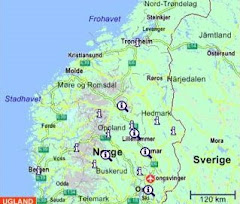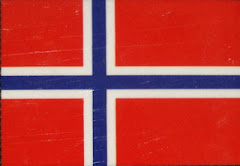
Our guide exuded passion for this place of Stiklestad:
its history,
present
and future
in connection with Norway's
Patron Saint Olav.
He explained how Olav was a descendant of Viking King Harald Fairhair. Olav's father, Harald Grenske, died before his birth. Olav was raised by his mother and stepfather on a grand farm in Ringerike. At age 12, Olav left on his first viking voyage.
According to the saga, Olav was of medium height, strong and stout, bold and well-spoken, and emerged victorious in several battles as a young sea king. Some say Olav inherited the Fairhair clan's characteristics of greed, savagery and licentiousness as well as the abilities to organize and rule.

Olav's passion became redirected when at age 18 he was introduced to the Christian faith and baptized, most likely while voyaging in France.
Before the time of Harald Fairhair, Norway was unorganized and loosely divided into small kingdoms. Toward the end of the ninth century, Harald Fairhair had unified a Norwegian state. The century following his death was marred by power struggles between provinces and families. Two earls rose to rule.
In 1014, Olav and his ships were at Gibraltar. He heard a voice saying
: Return to your allodium, for you shall be King of Norway for eternity. He did not understand, but realized it as a sign to head north. Olav Haraldsson began to consider himself the rightful Norwegian royal heir.
(Our guide directed our eyes to another sign: this mural under the south window in the Stiklestad Church which displays Olav falling asleep before his final battle in 1030 and dreaming of his being hailed the king to successfully unify Norway.)

In 1015, Olav returned from his viking voyages, was soon declared king, went onto challenge the Earls of Laude and their allies and came out victorious in a battle near Nesjar on Palm Sunday 1016.
Although Olav was hailed king, Norway remained divided, politically and religiously. Powerful chieftains controlled the vast areas of land. The Viking era was nearing its end. Old chieftains could no longer rely on overseas naval raids to enrich themselves. Power transferred to those utilizing the land's agricultural resources.
Olav's reign emphasized law and order to an extent greater than his predecessors. Offenders who tried to buy freedom with gold and riches were decapitated. Thieves lost their hands and feet. "With sharp weapons, he did away with many vikings," said his court poet in the poem
Årvedråpa.That was just the start of the vendetta against Olav. Area farmers turned against Olav when this king took his Christian faith to a new level, outlawing pagan cults with the harsh penalties, even death, for those in defiance.

Together with Bishop Grimkjell, Olav laid the foundation for the organized Norwegian church, including Christian courts, provisions for annual freeing of serfs, the outlawing of polygamy and abandoning newborns in the forest, as well as harsh penalties for rape and robbery of women.
All this came to a head in 1028 when Danish King Canute the Great made an alliance with several petty Norwegian kings. Canute sent gifts to people around the country to offer friendship and as an undermining chance to conquer the country. The chieftains saw a victory by Canute as an opportunity to regain freedoms that Olav had revoked. Their powerful allegiance with the Danish king forced Olav north into exile in Gardarike (Russia). Canute was hailed king. He installed 17-year-old Håkon Eiriksson as governor of Norway. The following summer Håkon drowned.
Olav saw his chance to recapture the throne. He had no significant allies. His brutality had made him unpopular among chieftains, peasants and his own family for having exterminated some as rival heirs. Yet his passion to unite Norway held strong.

Olav gathered an army on his was through Sweden and in July 1030 crossed the Verdal mountains into Trøndelag.
Peasant armies rose up to protect their lives and property against Olav, the King whom they felt had acted unjustly against them. On July 30, 1030, Olav and his army reached Stiklestad where they faced twice their number in peasant soldiers. The King's army soon decimated. According to legend, Olav died of ax wounds to his foot and throat and a spear to his gut.
Miracles began occurring immediately. During battle, a soldier – who inflicted one of the king's mortal wounds – had himself received a cut to his hand. When the soldier later came into contact with the king's blood, his wound no longer needed bandaging and healed quickly (as depicted in this mural below).

Supporters of Olav secretively moved his body to Trondheim for burial in the dunes of the river Nidelva. Before long at his gravesite, people began reporting miracles: sight restored to the blind; hearing to the deaf; speech to the mute.
To pagans, these signs represented a divine king. To Christians, a saint. "By the King's consent and verdict of all people," Bishop Grimkjell sanctified Olav. A spring soon burst forth at Olav's first burial site. Those who were ill and drank of its waters reported restored health.
A year after the battle, Olav's body was exhumed and found fresh with its hair and beard having kept growing. Word spread. Thousands throughout Europe began pilgrimaging to Trondheim for healing, Christian conversion and worship. A century later, Olav's body was laid in the Nidaros Cathedral.
Following, Olav's death, the Danish king's mistress and son were sent to rule Norway. Their authoritarian ways were not to the chieftains' liking. Thus, the perception of Olav changed. Things he had accomplished were appreciated in hindsight. Rallying around St. Olav provided a valuable tool for unifying a new Norwegian state and church in the centuries to come.

Our guide put his arms over the Olav under the south window and then raised his arms to the Christ mural behind the altar to explain, like Christ, Olav lost his life as an earthly king so that a nation could be born – one where he would reign eternal.
On July 30, 1030, a new unified nation of Norway took root with Saint Olav as "Rex Perpetuss Norvegia" – the
Eternal King of Norway.(Note: In commemoration, the people raised an altar here on the spot where the king fell in that Battle of Stiklestad.)
 We spent nearly three hours at Stiklestad and took in only a fraction of its attractions. (Note the pink arrows on the Stiklestad Map.) After visiting the church and cemetery,
We spent nearly three hours at Stiklestad and took in only a fraction of its attractions. (Note the pink arrows on the Stiklestad Map.) After visiting the church and cemetery,
 Later we toured
Later we toured

 Kjell accompanied me to
Kjell accompanied me to 
































